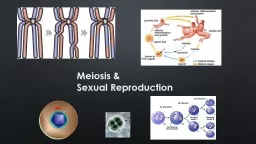

Cell division Asexual reproduction Mitosis produce cells with same information identical daughter cells exact copies clones same amount of DNA same number of chromosomes same genetic information ID: 930952
Download Presentation The PPT/PDF document "2005-2006 Meiosis & Sexual Reproduct..." is the property of its rightful owner. Permission is granted to download and print the materials on this web site for personal, non-commercial use only, and to display it on your personal computer provided you do not modify the materials and that you retain all copyright notices contained in the materials. By downloading content from our website, you accept the terms of this agreement.
Slide1
2005-2006
Meiosis &Sexual Reproduction
Slide2Cell division / Asexual reproduction
Mitosisproduce cells with same informationidentical daughter cellsexact copiesclonessame amount of DNA same number of chromosomessame genetic information
Slide3Asexual reproduction
Single-celled eukaryotes reproduce asexuallyyeastParameciumAmoebaSimple multicellular
eukaryotes reproduce asexuallyHydrabudding
Slide4Budding in Yeast
Binary fission in Amoeba
Slide5How about the rest of us?
What if a complex multicellular organism (like us) wants to reproduce?joining of egg + spermDo we make egg & sperm by mitosis?
46
46
+
92
egg
sperm
zygote
Slide6Human female karyotype
Slide7Human male karyotype
Slide8How do we make sperm & eggs?
reduce 46 chromosomes
23 chromosomesHalve the number of chromosomes
23
23
46
egg
sperm
46
meiosis
46
fertilization
23
23
Slide9Meiosis: production of gametes
Alternating processes,
alternating stageschromosome number must be reduceddiploid haploid2n
nhumans: 46 23meiosis reduces chromosome numberfertilization restores chromosome numberhaploid diploid
n 2n
Slide10Homologous chromosomes
Paired chromosomesboth chromosomes of a pair carry genes
control same inherited charactershomologous = same information
diploid
2n
homologous
chromosomes
double stranded
homologous chromosomes
Slide11Sexual reproduction: Fertilization
- 2 copies- diploid
- 2n- 1 copy
- haploid- 1n
from Mom
from Dad
Slide12Making gametes for the next generation
- 2 copies
- diploid
- 2n
- 1 copy- haploid
- 1n
Slide13Meiosis = reduction division
Meiosis
special cell division in sexually reproducing organismsreduce 2n 1ndiploid haploid
halfmakes gametes sperm, eggs
Warning: meiosis evolved from mitosis, so stages & “machinery” are similar but the processes are radically different. Do not confuse the two!
Slide142nd division
of meiosis separates
sister chromatids
1st division of meiosis separates
homologous pairsDouble division
of meiosis
DNA replication
Slide152n =
6 doublestranded
2n = 6 single
strandedPreparing for meiosis1st step of meiosisDuplication of DNAWhy bother?
meiosis evolved after mitosis convenient to use “machinery” of mitosisDNA replicated in S phase of
interphase of MEIOSIS(just like in mitosis)
M1 prophase
Slide162n =
4doublestranded
2n = 4 single
strandedPreparing for meiosis
prophase1
2n =
4
double
stranded
1st division
of meiosis separates
homologous pairs
1n
=
2
double
stranded
tetrad
synapsis
telophase1
metaphase1
Slide17Meiosis 2
1n = 2
doublestranded
1n = 2singlestranded
metaphase2
telophase2
prophase2
1n
=
2
double
stranded
2nd division
of
meiosis separates
sister chromatids
Slide18Steps of meiosis
Meiosis 1interphaseprophase 1metaphase 1anaphase 1telophase 1
Meiosis 2prophase 2metaphase 2anaphase 2telophase 2
2nd division of meiosis separates sister chromatids
(1n 1n)
* just like mitosis *
1st division
of
meiosis separates
homologous pairs
(2n
1n)
Slide19Slide20Slide21Meiosis 1
Slide22Meiosis 2
Slide23Mitosis vs. Meiosis
Slide24Mitosis vs. Meiosis
Mitosis1 divisiondaughter cells genetically identical to parent cellproduces
2 cells2n 2nproduces cells for growth & repair
no crossing over Meiosis2 divisionsdaughter cells genetically different from parent
produces 4 cells2n
1nproduces gametescrossing over
Slide25Crossing over
During Prophase 1
homologous pairs swappieces of chromosomesister chromatids intertwinecrossing over
tetrad
synapsis
Slide26Crossing over
3 stepscross overbreakage of DNAre-fusing of DNANew combinations of traits
Slide27Genetic variation
Meiosis & crossing over introduce great genetic variation
to populationdrives evolution
Slide28The value of meiosis
Meiosis introduces
genetic variationgametes of offspring do not have same genes as gametes from parentsgenetic recombination
random assortment in humans produces 223 (8,388,608) different combinations
from Mom
from Dad
new gametes
made by offspring
Slide29And more variation…
Crossing over
creates completely new combinations of traits in next generation
Slide30Random fertilization
Any 2 parents will produce a zygote with over 70 trillion (223 x 223) diploid combinations
Slide31Sources of genetic variability
Genetic variability in sexual reproduction
independent assortmenthomologous chromosomes in Meiosis 1crossing overbetween homologous chromosomes in prophase 1random fertilizationrandom ovum fertilized by a random sperm
metaphase1
Slide32Sexual reproduction creates variability
Sexual reproduction allows us to maintain both genetic similarity & differences.
Martin & Charlie Sheen, Emilio Estevez
Michael & Kirk
Douglas
Baldwin brothers
Slide33Differences across kingdoms
Not all organisms use haploid & diploid stages in same waywhich one is dominant (2n or n) differsbut still alternate between haploid & diploidhave to for sexual reproduction